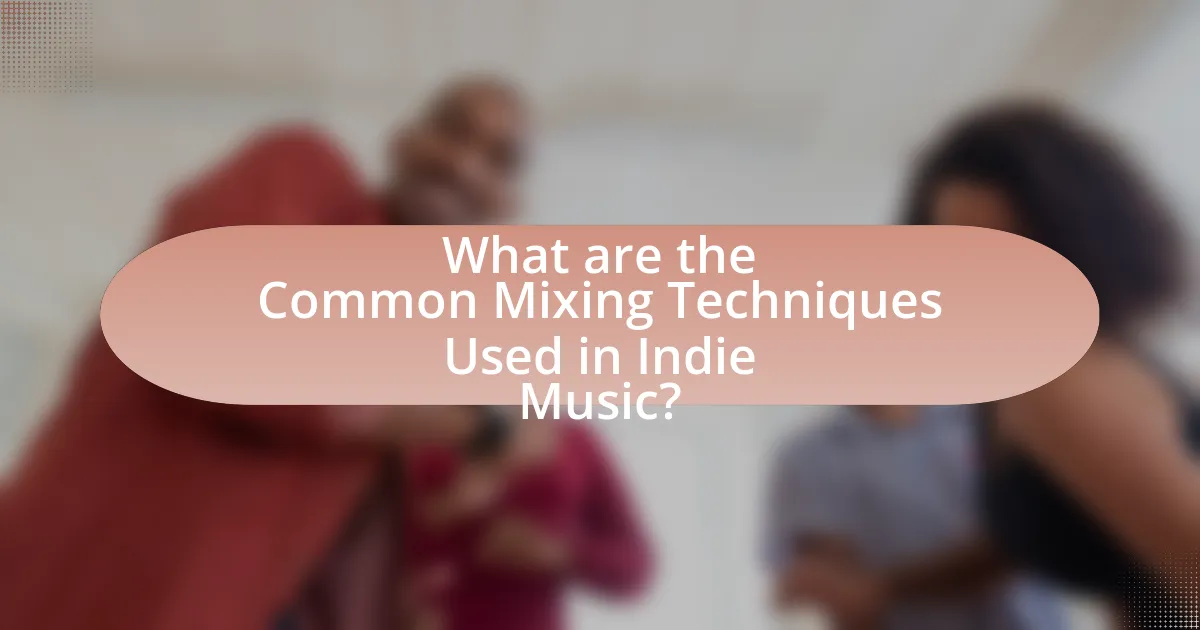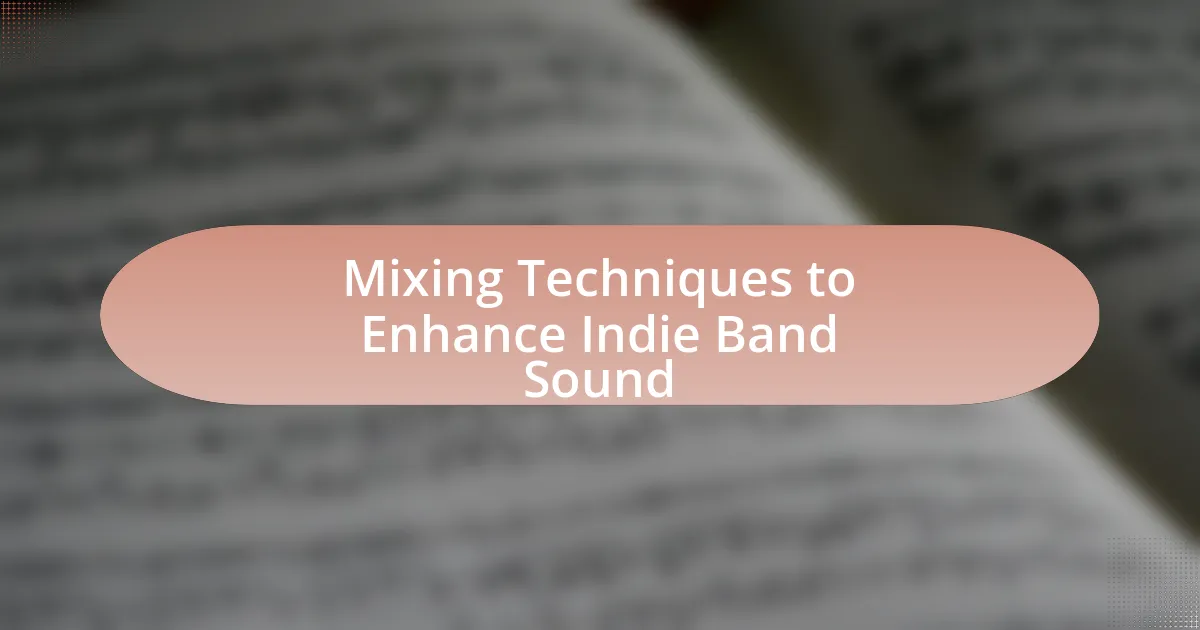The article focuses on mixing techniques that enhance the sound of indie bands, emphasizing the importance of EQ, reverb, panning, and compression. These techniques are crucial for achieving clarity, balance, and emotional impact in music, allowing individual instruments and vocals to complement each other while maintaining the band’s unique character. The article also addresses common challenges indie bands face in achieving a polished sound, the role of mixing in differentiating them in a competitive market, and best practices for effective mixing at home. Additionally, it highlights essential mixing plugins and resources for learning mixing techniques, providing a comprehensive overview of how to improve sound quality in indie music production.

What are Mixing Techniques to Enhance Indie Band Sound?
Mixing techniques to enhance indie band sound include the use of EQ, reverb, panning, and compression. EQ allows for the adjustment of frequency ranges, helping to clarify individual instruments and vocals, which is crucial in a genre often characterized by diverse sounds. Reverb adds depth and space, creating a more immersive listening experience, while panning helps to create a stereo image, allowing listeners to perceive the arrangement more dynamically. Compression controls the dynamic range, ensuring that softer sounds are audible while preventing louder sounds from overwhelming the mix. These techniques are widely recognized in audio production, with studies showing that effective mixing can significantly improve listener engagement and overall sound quality.
How do mixing techniques influence the overall sound of an indie band?
Mixing techniques significantly influence the overall sound of an indie band by shaping the balance, clarity, and emotional impact of the music. Techniques such as equalization (EQ), compression, reverb, and panning allow sound engineers to enhance individual instruments and vocals, ensuring they complement each other while maintaining the band’s unique character. For instance, EQ can be used to carve out space for each instrument in the frequency spectrum, preventing muddiness and enhancing clarity, which is crucial for the intricate arrangements often found in indie music. Additionally, compression can control dynamics, making softer sounds more audible and adding punch to louder elements, thus affecting the overall energy of a track. The use of reverb can create a sense of space and depth, contributing to the atmospheric qualities that are often a hallmark of indie music. Ultimately, these mixing techniques not only refine the technical aspects of the sound but also enhance the emotional resonance of the music, making it more engaging for listeners.
What are the key elements of sound that mixing techniques affect?
The key elements of sound that mixing techniques affect include volume, frequency balance, stereo imaging, dynamics, and effects processing. Volume adjustments ensure that each instrument and vocal is heard clearly in the mix, while frequency balance involves equalization to enhance or reduce specific frequency ranges, ensuring clarity and preventing muddiness. Stereo imaging creates a sense of space by positioning sounds within the left and right channels, enhancing the listener’s experience. Dynamics control, through compression and limiting, manages the loudness variations of sounds, ensuring a consistent output level. Lastly, effects processing, such as reverb and delay, adds depth and texture to the sound, contributing to the overall atmosphere of the mix. These elements are crucial for achieving a polished and professional sound in music production.
How does mixing contribute to the emotional impact of a song?
Mixing significantly contributes to the emotional impact of a song by balancing elements such as vocals, instruments, and effects to create a cohesive sound. This process allows for the enhancement of specific frequencies and dynamics, which can evoke particular feelings in the listener. For instance, emphasizing the mid-range frequencies of a vocal track can make the lyrics feel more intimate, while adding reverb can create a sense of space and longing. Studies have shown that the way sounds are mixed can influence emotional responses; for example, a study published in the Journal of Experimental Psychology found that certain mixing techniques can enhance the perceived emotional intensity of music. Thus, effective mixing not only shapes the sonic landscape but also amplifies the emotional narrative of a song.
Why are mixing techniques particularly important for indie bands?
Mixing techniques are particularly important for indie bands because they allow for the creation of a polished and professional sound that can compete in a crowded music market. Indie bands often operate with limited budgets and resources, making effective mixing essential to enhance the clarity and impact of their music. For instance, a well-executed mix can highlight unique instrumental arrangements and vocal performances, which are crucial for establishing an indie band’s identity. Additionally, according to a study by the Berklee College of Music, high-quality mixing can significantly improve listener engagement and retention, which is vital for indie bands seeking to build a fanbase.
What challenges do indie bands face in achieving a polished sound?
Indie bands face several challenges in achieving a polished sound, primarily due to limited access to professional recording equipment and expertise. Many indie bands operate on tight budgets, which restricts their ability to hire experienced sound engineers or utilize high-quality studio facilities. This financial constraint often leads to subpar recording conditions, resulting in a less refined final product. Additionally, indie bands may lack the technical knowledge required for effective mixing and mastering, which are crucial processes for achieving a polished sound. According to a study by the Berklee College of Music, many independent artists report that insufficient resources and knowledge in audio production significantly hinder their ability to compete with mainstream acts.
How can mixing techniques help indie bands stand out in a crowded market?
Mixing techniques can help indie bands stand out in a crowded market by enhancing their unique sound and creating a polished, professional quality that attracts listeners. Effective mixing allows bands to emphasize distinctive elements of their music, such as vocal clarity, instrumental balance, and dynamic range, which can differentiate them from mainstream acts. For instance, using techniques like panning, equalization, and reverb can create a more immersive listening experience, making the music more memorable. Additionally, research indicates that well-mixed tracks are more likely to be shared and streamed, increasing visibility and engagement in a competitive landscape.

What are the Common Mixing Techniques Used in Indie Music?
Common mixing techniques used in indie music include layering, panning, and the use of effects such as reverb and delay. Layering involves stacking multiple tracks of instruments or vocals to create a fuller sound, which is essential in indie music to achieve a rich texture. Panning is utilized to distribute sounds across the stereo field, enhancing the spatial quality of the mix. Additionally, effects like reverb add depth and ambiance, while delay can create rhythmic interest and complexity. These techniques are widely adopted in indie music production to craft a unique and engaging listening experience.
What role does equalization play in mixing for indie bands?
Equalization plays a crucial role in mixing for indie bands by allowing sound engineers to adjust the frequency balance of individual tracks, enhancing clarity and separation. This process helps to eliminate muddiness, ensuring that each instrument and vocal can be distinctly heard in the mix. For instance, cutting low frequencies on guitars can prevent overlap with the bass, while boosting mid-range frequencies on vocals can improve their presence. Effective equalization techniques can significantly impact the overall sonic quality of a track, making it more polished and professional.
How can EQ be used to enhance individual instruments?
EQ can be used to enhance individual instruments by adjusting frequency ranges to improve clarity and presence. For example, boosting high frequencies can add brightness to vocals or guitars, while cutting low frequencies can reduce muddiness in bass instruments. This targeted manipulation allows each instrument to occupy its own sonic space, preventing frequency overlap and ensuring a balanced mix. Studies in audio engineering show that proper EQ adjustments can significantly improve the perceived quality of a mix, making it more engaging for listeners.
What are common EQ mistakes to avoid in indie music mixing?
Common EQ mistakes to avoid in indie music mixing include excessive boosting of frequencies, neglecting to cut unwanted frequencies, and failing to consider the overall mix context. Excessive boosting can lead to a harsh sound and frequency masking, where important elements become indistinct. Neglecting to cut unwanted frequencies, such as low-end rumble or harsh high frequencies, can clutter the mix and reduce clarity. Additionally, failing to consider how each element interacts within the mix can result in an unbalanced sound, as each instrument may not occupy its own sonic space effectively. These mistakes can detract from the overall quality of the indie music mix.
How does reverb contribute to the sound of an indie band?
Reverb enhances the sound of an indie band by creating a sense of space and depth in the music. This effect allows individual instruments and vocals to blend more cohesively, giving the overall mix a more atmospheric quality. In indie music, where emotional expression is key, reverb can evoke feelings of nostalgia or intimacy, aligning with the genre’s aesthetic. Studies show that reverb can increase listener engagement by making the sound more immersive, which is particularly effective in live performances and recordings.
What types of reverb are most effective for different instruments?
Different types of reverb are effective for various instruments, enhancing their sound in unique ways. For vocals, plate reverb is often preferred due to its smooth and bright characteristics, which help to add warmth and presence. Guitars benefit from spring reverb, providing a vintage feel that complements their tonal qualities. For drums, room reverb is effective as it simulates the natural acoustics of a space, adding depth without overwhelming the sound. Synths often work well with hall reverb, creating expansive soundscapes that enhance their electronic textures. Each type of reverb serves to complement the specific sonic attributes of the instrument, ensuring clarity and cohesion in the mix.
How can reverb settings affect the overall mix?
Reverb settings significantly affect the overall mix by altering the spatial perception and depth of audio elements. When reverb is applied, it creates a sense of space, making sounds appear closer or further away, which can enhance the listener’s experience. For instance, a longer reverb time can create a lush, ambient feel, while a shorter reverb can add clarity and definition to individual instruments. Studies show that appropriate reverb settings can improve the cohesiveness of a mix, as they help blend different elements together, making them sound more unified. Additionally, excessive reverb can muddy the mix, leading to a loss of clarity and detail, which is crucial in indie music where instrumentation and vocal clarity are often paramount.

How Can Indie Bands Implement Effective Mixing Techniques?
Indie bands can implement effective mixing techniques by utilizing a combination of proper EQ, dynamic range control, and spatial effects. Proper equalization (EQ) allows bands to carve out space for each instrument, ensuring clarity and balance in the mix. For instance, cutting unnecessary low frequencies from guitars can prevent muddiness, while boosting mid-range frequencies can enhance vocal presence. Dynamic range control through compression helps maintain consistent levels, making the mix sound polished and professional. Additionally, spatial effects like reverb and delay can create depth and dimension, making the sound more immersive. These techniques are supported by industry standards, as evidenced by the success of numerous indie bands who have adopted similar practices, leading to commercially viable recordings.
What are the best practices for mixing indie music at home?
The best practices for mixing indie music at home include using high-quality monitoring equipment, balancing levels, applying EQ effectively, utilizing compression wisely, and incorporating reverb and delay for depth. High-quality studio monitors or headphones ensure accurate sound representation, which is crucial for making informed mixing decisions. Balancing levels involves adjusting the volume of each track to create a cohesive mix, while effective EQ helps to carve out space for each instrument, preventing frequency clashes. Compression controls dynamics, ensuring that no elements are too loud or too soft, which is essential for maintaining listener engagement. Finally, reverb and delay add spatial effects, enhancing the overall sound without overwhelming the mix. These practices are supported by industry standards, as many successful indie recordings utilize these techniques to achieve clarity and depth in their sound.
How can bands utilize software tools for mixing?
Bands can utilize software tools for mixing by employing digital audio workstations (DAWs) to create, edit, and refine their sound. DAWs like Pro Tools, Ableton Live, and Logic Pro provide features such as multi-track recording, audio editing, and effects processing, which enable bands to achieve professional-quality mixes. For instance, the use of plugins for equalization, compression, and reverb allows bands to enhance individual tracks and create a cohesive sound. Additionally, software tools facilitate collaboration by enabling remote access to projects, allowing band members to contribute from different locations. This integration of technology in the mixing process has been shown to improve sound quality and streamline workflow, making it an essential aspect of modern music production.
What are essential mixing plugins for indie bands?
Essential mixing plugins for indie bands include equalizers, compressors, reverb, and delay. Equalizers, such as FabFilter Pro-Q 3, allow for precise frequency adjustments, enhancing clarity and balance in mixes. Compressors, like Waves SSL G-Master Buss Compressor, help control dynamics, ensuring a polished sound. Reverb plugins, such as Valhalla Room, add depth and space, creating a more immersive listening experience. Delay effects, like Soundtoys EchoBoy, can add rhythmic interest and texture to tracks. These plugins are widely used in the industry, making them crucial tools for indie bands aiming to achieve professional-quality mixes.
How can bands troubleshoot common mixing issues?
Bands can troubleshoot common mixing issues by systematically identifying and addressing specific problems such as frequency clashes, volume imbalances, and effects misapplication. For instance, frequency clashes can be resolved by using equalization to carve out space for each instrument, ensuring that they do not compete in the same frequency range. Volume imbalances can be corrected by adjusting the levels of each track to achieve a balanced mix, often utilizing reference tracks for comparison. Additionally, effects misapplication can be addressed by carefully selecting and applying reverb and delay to enhance rather than muddy the mix. These strategies are supported by industry practices, where sound engineers frequently employ EQ adjustments and level balancing to create clear and cohesive mixes.
What are the signs of a poorly mixed track?
Signs of a poorly mixed track include imbalanced levels, where certain instruments or vocals overpower others, leading to a lack of clarity. Additionally, a poorly mixed track may exhibit muddiness, characterized by a lack of definition in the low frequencies, making it difficult to distinguish individual sounds. Harshness in the high frequencies can also indicate poor mixing, causing listener fatigue. Furthermore, a lack of spatial depth, where sounds feel flat and unengaging, is another sign of inadequate mixing. These issues can detract from the overall listening experience and are often evident in tracks that have not undergone proper mixing techniques.
How can bands fix muddiness in their mixes?
Bands can fix muddiness in their mixes by using equalization (EQ) to carve out space for each instrument. By applying high-pass filters to remove low-frequency rumble from non-bass instruments, bands can reduce overlap in the frequency spectrum. Additionally, cutting frequencies around 200-400 Hz can help eliminate boxiness, which contributes to muddiness. Research shows that targeted EQ adjustments can significantly improve clarity in mixes, as evidenced by the practices of professional mixing engineers who often utilize these techniques to achieve cleaner soundscapes.
What tips can enhance the mixing process for indie bands?
To enhance the mixing process for indie bands, focus on achieving clarity and balance in the mix. Start by organizing tracks effectively, grouping similar instruments together, which allows for easier adjustments and a more cohesive sound. Utilize EQ to carve out space for each instrument, ensuring that frequencies do not clash; for example, cutting low frequencies from guitars can help vocals stand out. Employ panning techniques to create a stereo image, placing instruments in different positions across the left and right channels to enhance depth. Additionally, use compression judiciously to control dynamics, ensuring that no single element overwhelms the mix. Finally, reference professional mixes in a similar genre to guide your decisions, as this can provide a benchmark for quality and balance.
How can collaboration with a professional mixer improve sound quality?
Collaboration with a professional mixer can significantly improve sound quality by utilizing their expertise in audio engineering and mixing techniques. Professional mixers possess advanced skills in balancing levels, equalization, and spatial effects, which enhance the clarity and depth of the sound. For instance, a study by the Audio Engineering Society highlights that professional mixing can increase perceived audio quality by up to 30% through precise adjustments and the use of high-quality equipment. This expertise ensures that each element of a track is optimized, resulting in a polished final product that resonates well with listeners.
What resources are available for learning mixing techniques?
Online courses, tutorials, and books are key resources for learning mixing techniques. Platforms like Coursera and Udemy offer structured courses taught by industry professionals, covering essential concepts and practical applications. YouTube hosts numerous channels dedicated to audio mixing, providing free tutorials that demonstrate techniques in real-time. Additionally, books such as “Mixing Secrets for the Small Studio” by Mike Senior provide in-depth knowledge and practical tips for effective mixing. These resources collectively equip learners with the skills needed to enhance their mixing abilities, supported by the expertise of established professionals in the field.


